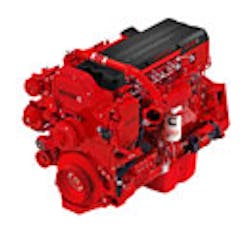Cummins shows off 2010 SCR engines
LOUISVILLE. Declaring Cummins Inc. was “ready with our SCR solution,” Jim Kelly, president of Cummins Engine Business, unveiled the manufacturer’s highway engine lineup engineered to meet the 2010 EPA diesel emissions rules at a media briefing here ahead of the Mid-America Trucking Show.
The new engines, which incorporate selective catalytic reduction (SCR) catalyst technology, are the ISX15 and ISX11.9 for heavy-truck applications and the ISB6.7, ISC8.3 and ISL9 for mid-range applications. “Exhaust gas recirculation (EGR) took us so far and now SCR is finishing the job [to meet the 2010 regs],” said Steve Charlton, vp--heavy-duty engineering.
According to Charlton, the ISX15 will provide better fuel economy, better performance and better reliability compared to today’s Cummins ISX engine. The ISX15 features the Cummins XPI fuel system, an enhanced cooled-EGR system, a single VGT turbocharger and the new Cummins Aftertreatment System that incorporates SCR catalyst technology together with the Cummins Particulate Filter that was introduced in 2007.
LOUISVILLE. Declaring Cummins Inc. was “ready with our SCR solution,” Jim Kelly, president of Cummins Engine Business, unveiled the manufacturer’s highway engine lineup engineered to meet the 2010 EPA diesel emissions rules at a media briefing here ahead of the Mid-America Trucking Show.
The new engines, which incorporate selective catalytic reduction (SCR) catalyst technology, are the ISX15 and ISX11.9 for heavy-truck applications and the ISB6.7, ISC8.3 and ISL9 for mid-range applications. “Exhaust gas recirculation (EGR) took us so far and now SCR is finishing the job [to meet the 2010 regs],” said Steve Charlton, vp--heavy-duty engineering.
According to Charlton, the ISX15 will provide better fuel economy, better performance and better reliability compared to today’s Cummins ISX engine. The ISX15 features the Cummins XPI fuel system, an enhanced cooled-EGR system, a single VGT turbocharger and the new Cummins Aftertreatment System that incorporates SCR catalyst technology together with the Cummins Particulate Filter that was introduced in 2007.
The ISX15 also features the XPI fuel system and a single overhead camshaft for an industry-leading power-to-weight ratio among big-bore engines, said Charlton. He stated that “fuel economy gains of up to 5% will be realized as compared to Cummins 2007 engines--and there will be gains of up to 9% anticipated compared to competitive 2010 in-cylinder solutions.” He noted ratings will be maintained from 400-600 hp, with torque outputs from 1450-2050 lb-ft.
Charlton described the new ISX11.9 as a “compact and lightweight medium-bore engine ideal for vocational trucks, day cabs, emergency vehicles and motorcoaches.” Sharing common cooled EGR, VGT turbocharger, XPI fuel system, electronic controls and aftertreatment system with the ISX15, the ISX11.9 will be offered with ratings from 310-425 horsepower and torque from 1150-1650 lb-ft.
“Customers can count on our engines to be even better in 2010 in every regard,” said Charlton. “Our heavy-duty engines for 2010 have a large ‘sweet spot’ due to the low-temperature NOx conversion capability of the copper-zeolite catalyst, which means that these engines are extraordinarily driver-friendly. Fuel economy gains can be realized with even the most inexperienced driver and, at the same time, the engines deliver performance that the driver will love.”
According to Charlton, the trio of mid-range engines “appear nearly identical to their 2007 counterparts with the addition of an SCR catalyst in the Cummins Aftertreatment System.” He said the ISB6.7, ISC8.3 and ISL9 engines continue to feature a single Cummins VGT turbocharger; the ISC8.3 and ISL9 engines also feature the XPI fuel system, as they have since 2007.
The most predominant change for 2010 is that the mid-range engines will share a common Electronic Control Module (ECM) with Cummins heavy-duty engines, with increased input/output and processing capability for full integration of the Cummins engine and aftertreatment system.
The ISB6.7 will be offered in ratings of 200-325 hp, with peak torque of 520-750 lb-ft; the ISC8.3 in ratings of 260-350 hp , with peak torque of 660-1000 lb-ft; and the ISL9 in ratings of 345-380 hp and peak torque of 1150-1300 lb-ft. Charlton noted that an ISB6.7 hybrid model will also be available in 2010.
Charlton said limited production of Cummins 2010 engines will begin in the fourth quarter of this year and full production will commence in January. He noted that Diesel Exhaust Fluid (DEF)—also known as urea--will be readily available at Cummins distributors, dealers and major truckstops.
“Cummins investment in our 2010 engines demonstrates that we are in the North American on-highway markets for the long haul,” concluded Kelly. “I am extremely confident in Cummins readiness for 2010 – across all areas of our business. And I’m confident that, with our OEM partners, we’ll continue to deliver high-performance products that help our customers operate cost-effectively and efficiently and, at the same time, reduce greenhouse gas emissions and dependence on foreign oil.”
For more information, go to www.everytime.cummins.com.
